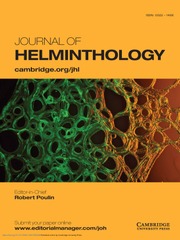No CrossRef data available.
Article contents
Second intermediate hosts range and their infection patterns in Orthosplanchnus arcticus, a potentially zoonotic parasite from the family Brachycladiidae (Digenea)
Published online by Cambridge University Press: 18 September 2025
Abstract
The family Brachycladiidae (Digenea) is a species-rich taxon restricted to marine mammals, well-known for its associated pathogenic load, but otherwise poorly understood. A major gap in our knowledge is their circulation pathways, as the life cycle has been elucidated only for a single brachycladiid species, Orthosplanchnus arcticus, a parasite of pinnipeds. Our goal was to determine whether small ocellate metacercariae previously reported from the Barents Sea edible cockles (Cerastoderma edule) belong to the brachycladiids. We searched for brachycladiid metacercariae in nine bivalve species across three sub-Arctic Seas. They were found in three cardiid species (Ciliatocardium ciliatum, C. edule, and Serripes groenlandicus) and a scallop, Chlamys islandica. Surprisingly, we discovered numerous brachycladiid metacercariae in a single infected whelk, Buccinum undatum. Obtained molecular genetic data (mitochondrial and nuclear ribosomal) indicated that all these metacercariae belong to O. arcticus. We used statistical analysis to explore potential preferences for the second intermediate hosts in this brachycladiid species. The results suggest that bivalve size, rather than species, more accurately predicts infection patterns with O. arcticus metacercariae. We also found no significant differences in morphology between metacercariae from different bivalve species. As such, O. arcticus exhibits broad specificity for the second intermediate hosts, with larger bivalve individuals showing higher infection rates. We discuss the factors underlying this broad specificity, the benefits of larger bivalve preference, and the unequal contribution of different hosts in the transmission of a parasite. Finally, we highlight the potential zoonotic risk associated with O. arcticus due to human consumption of its intermediate hosts.
Information
- Type
- Research Paper
- Information
- Copyright
- © The Author(s), 2025. Published by Cambridge University Press

